2000 BMW 328Ci COUPE key battery
[x] Cancel search: key batteryPage 22 of 189
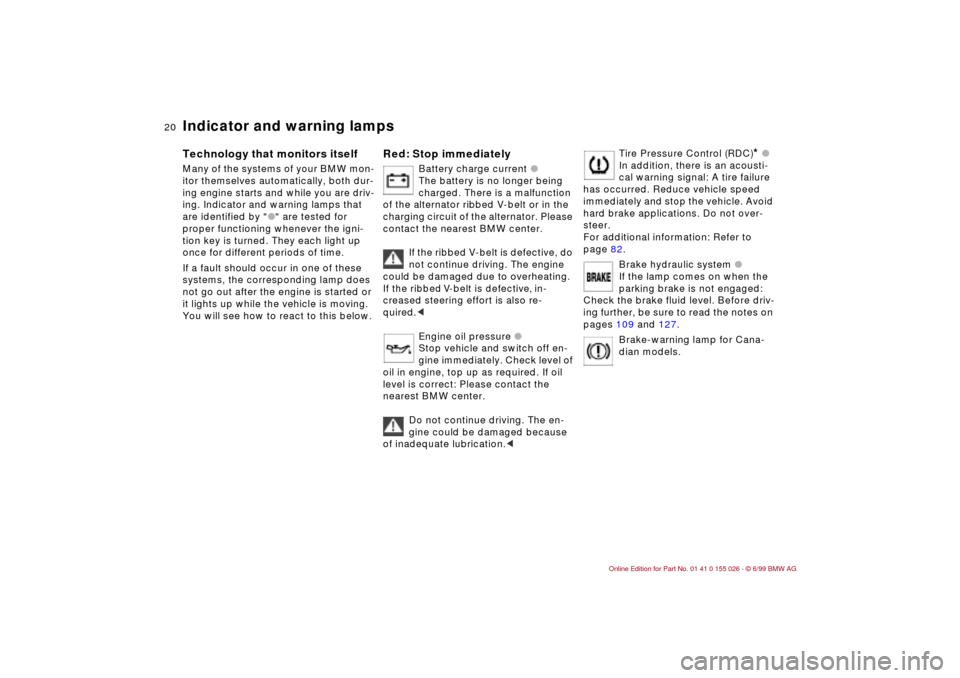
20n
Indicator and warning lamps
Technology that monitors itself
Many of the systems of your BMW mon-
itor themselves automatically, both dur-
ing engine starts and while you are driv-
ing. Indicator and warning lamps that
are identified by "
l
" are tested for
proper functioning whenever the igni-
tion key is turned. They each light up
once for different periods of time.
If a fault should occur in one of these
systems, the corresponding lamp does
not go out after the engine is started or
it lights up while the vehicle is moving.
You will see how to react to this below.
Red: Stop immediately
Battery charge current
l
The battery is no longer being
charged. There is a malfunction
of the alternator ribbed V-belt or in the
charging circuit of the alternator. Please
contact the nearest BMW center.
If the ribbed V-belt is defective, do
not continue driving. The engine
could be damaged due to overheating.
If the ribbed V-belt is defective, in-
creased steering effort is also re-
quired.
<
Engine oil pressure
l
Stop vehicle and switch off en-
gine immediately. Check level of
oil in engine, top up as required. If oil
level is correct: Please contact the
nearest BMW center.
Do not continue driving. The en-
gine could be damaged because
of inadequate lubrication.
<
Tire Pressure Control (RDC)
* l
In addition, there is an acousti-
cal warning signal: A tire failure
has occurred. Reduce vehicle speed
immediately and stop the vehicle. Avoid
hard brake applications. Do not over-
steer.
For additional information: Refer to
page 82.
Brake hydraulic system l
If the lamp comes on when the
parking brake is not engaged:
Check the brake fluid level. Before driv-
ing further, be sure to read the notes on
pages 109 and 127.
Brake-warning lamp for Cana-
dian models.
Page 34 of 189
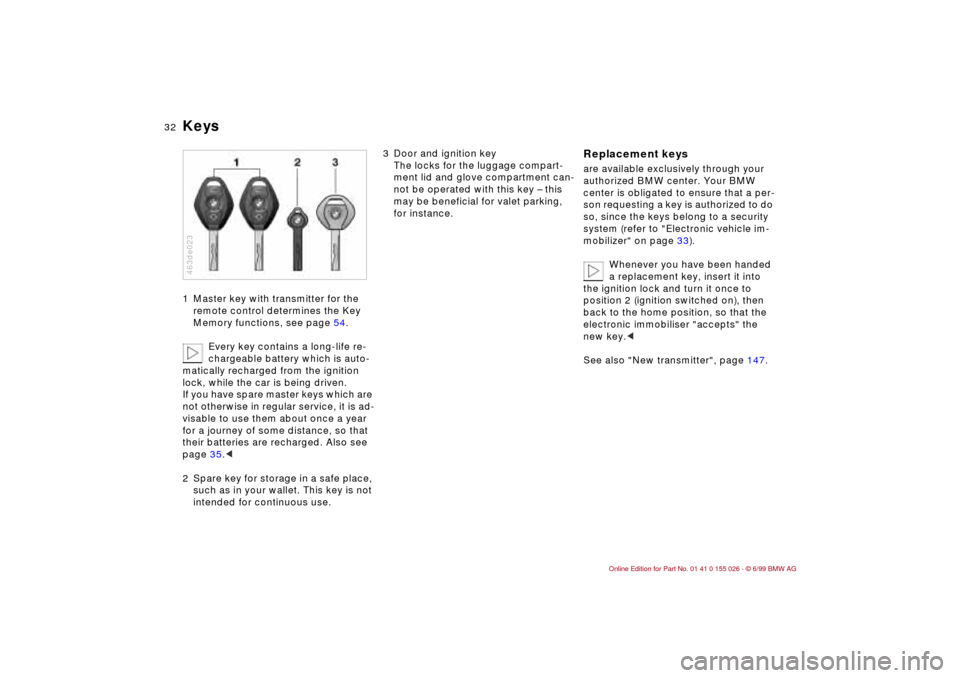
32n
Keys1 Master key with transmitter for the
remote control determines the Key
Memory functions, see page 54.
Every key contains a long-life re-
chargeable battery which is auto-
matically recharged from the ignition
lock, while the car is being driven.
If you have spare master keys which are
not otherwise in regular service, it is ad-
visable to use them about once a year
for a journey of some distance, so that
their batteries are recharged. Also see
page 35.<
2 Spare key for storage in a safe place,
such as in your wallet. This key is not
intended for continuous use.463de023
3 Door and ignition key
The locks for the luggage compart-
ment lid and glove compartment can-
not be operated with this key – this
may be beneficial for valet parking,
for instance.
Replacement keysare available exclusively through your
authorized BMW center. Your BMW
center is obligated to ensure that a per-
son requesting a key is authorized to do
so, since the keys belong to a security
system (refer to "Electronic vehicle im-
mobilizer" on page 33).
Whenever you have been handed
a replacement key, insert it into
the ignition lock and turn it once to
position 2 (ignition switched on), then
back to the home position, so that the
electronic immobiliser "accepts" the
new key.<
See also "New transmitter", page 147.
Page 37 of 189
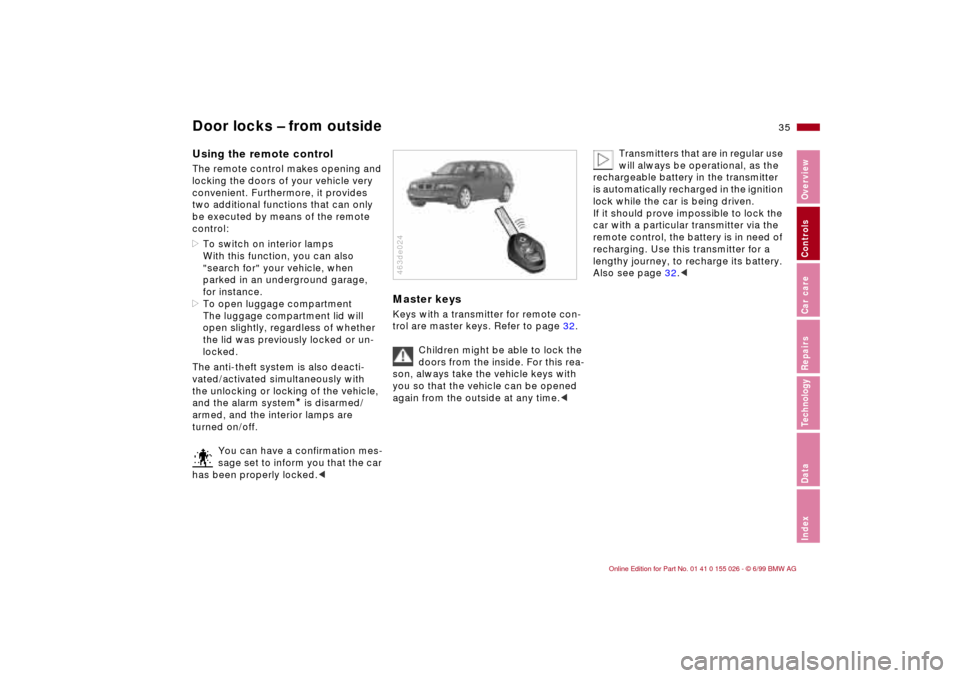
35n
RepairsIndexOverview Controls Car care Technology Data
Door locks – from outsideUsing the remote control The remote control makes opening and
locking the doors of your vehicle very
convenient. Furthermore, it provides
two additional functions that can only
be executed by means of the remote
control:
>To switch on interior lamps
With this function, you can also
"search for" your vehicle, when
parked in an underground garage,
for instance.
>To open luggage compartment
The luggage compartment lid will
open slightly, regardless of whether
the lid was previously locked or un-
locked.
The anti-theft system is also deacti-
vated/activated simultaneously with
the unlocking or locking of the vehicle,
and the alarm system
* is disarmed/
armed, and the interior lamps are
turned on/off.
You can have a confirmation mes-
sage set to inform you that the car
has been properly locked.<
Master keysKeys with a transmitter for remote con-
trol are master keys. Refer to page 32.
Children might be able to lock the
doors from the inside. For this rea-
son, always take the vehicle keys with
you so that the vehicle can be opened
again from the outside at any time.<463de024
Transmitters that are in regular use
will always be operational, as the
rechargeable battery in the transmitter
is automatically recharged in the ignition
lock while the car is being driven.
If it should prove impossible to lock the
car with a particular transmitter via the
remote control, the battery is in need of
recharging. Use this transmitter for a
lengthy journey, to recharge its battery.
Also see page 32.<
Page 44 of 189

42n
Alarm system
*
The conceptThe vehicle's alarm system responds:
>When a door, the hood or the lug-
gage compartment lid is opened
>To motion within the passenger com-
partment (interior motion sensor)
>To a change in the inclination of the
vehicle, e. g. during an attempted
wheel theft of unauthorized towing
>To interruption of battery voltage.
The alarm system signals unauthorized
access to the vehicle or an attempted
theft in different ways:
>Sounding an acoustical alarm for
30 seconds
>Activating the hazard warning flash-
ers for approx. five minutes
*.
To activate and deactivate the
alarm systemWhen the vehicle is locked or unlocked
by using a key or with the remote con-
trol, the alarm system is also simulta-
neously armed or disarmed.
The interior motion sensor is activated
approx. 30 seconds after you have fin-
ished locking the car.
If the alarm system has been armed
correctly, the hazard warning flashers
cycle once. An acoustic warning signal
sounds at the same time.
You can have various confirmation
messages set to inform you that
the alarm system has been armed or
disarmed.<
You can also open the luggage com-
partment lid when the system is armed
by pressing button 3 of the remote con-
trol (refer to page 37). When it is closed,
the lid is once again secured.
Indicator lamp displaysThe indicator lamp is located under the
inside rearview mirror.
>When the indicator lamp flashes
continuously: The system is armed
>The indicator lamp flashes when it is
armed: The door(s), the hood or lug-
gage compartment lid are not com-
pletely closed. Even if you do not
close the alerted area, the system be-
gins to monitor the remaining areas,
and the indicator lamp flashes contin-
uously after 10 seconds. However,
the interior motion sensor is not
activated
>If the indicator lamp goes out when
the system is disarmed: No manipula-
tion or attempted intrusions have
been detected in the period since the
system was armed460de105
Page 88 of 189
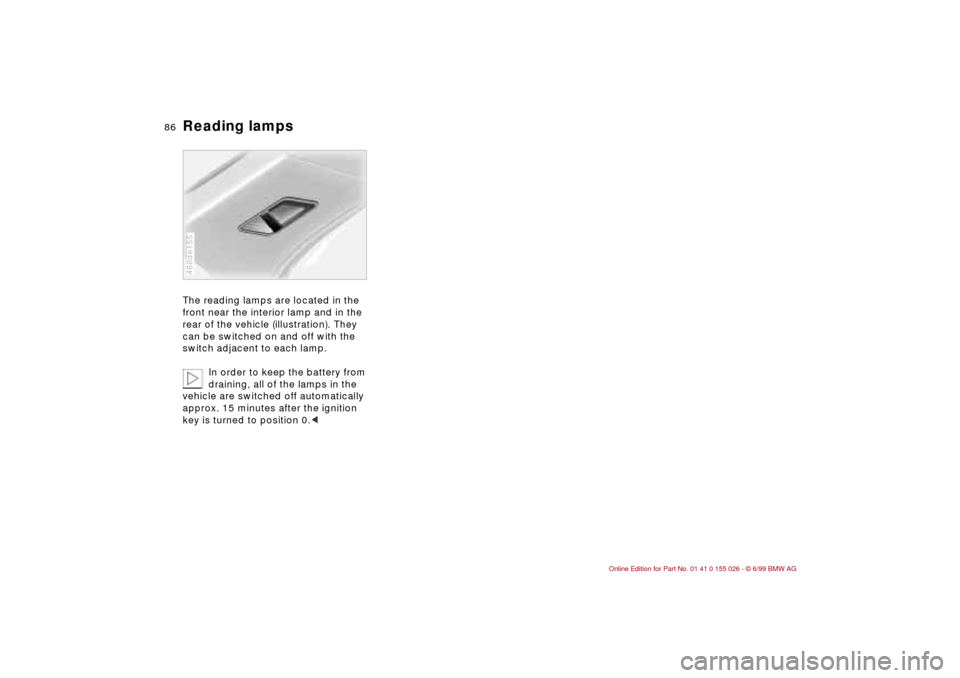
86n
Reading lamps
The reading lamps are located in the
front near the interior lamp and in the
rear of the vehicle (illustration). They
can be switched on and off with the
switch adjacent to each lamp.
In order to keep the battery from
draining, all of the lamps in the
vehicle are switched off automatically
approx. 15 minutes after the ignition
key is turned to position 0.< 460de155
Page 153 of 189
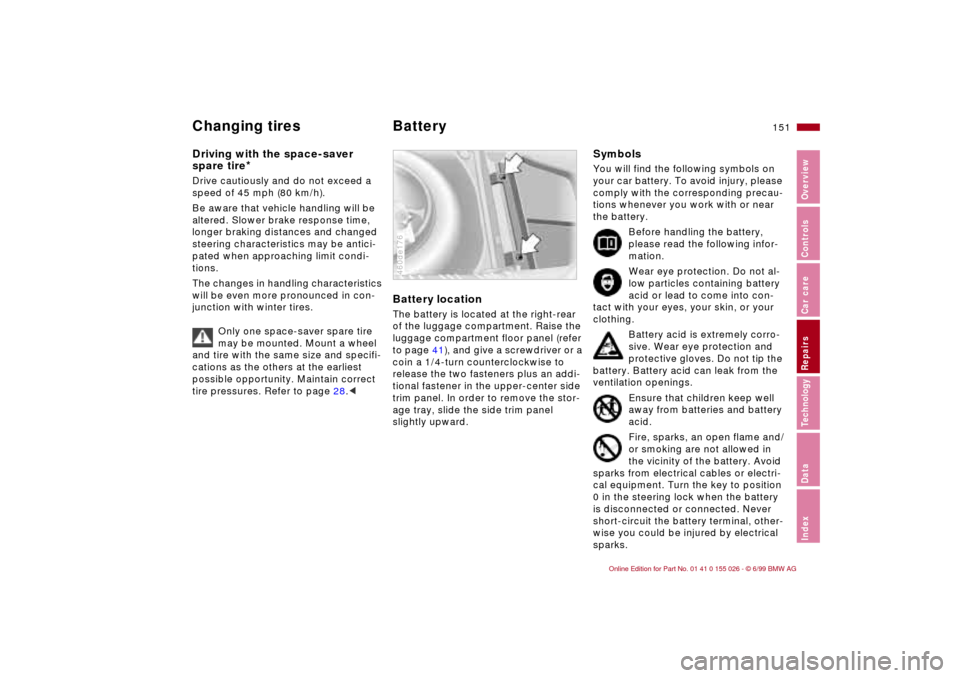
151n
RepairsIndexOverview Controls Car care Technology Data
Changing tires Battery Driving with the space-saver
spare tire
*
Drive cautiously and do not exceed a
speed of 45 mph (80 km/h).
Be aware that vehicle handling will be
altered. Slower brake response time,
longer braking distances and changed
steering characteristics may be antici-
pated when approaching limit condi-
tions.
The changes in handling characteristics
will be even more pronounced in con-
junction with winter tires.
Only one space-saver spare tire
may be mounted. Mount a wheel
and tire with the same size and specifi-
cations as the others at the earliest
possible opportunity. Maintain correct
tire pressures. Refer to page 28.<
Battery location The battery is located at the right-rear
of the luggage compartment. Raise the
luggage compartment floor panel (refer
to page 41), and give a screwdriver or a
coin a 1/4-turn counterclockwise to
release the two fasteners plus an addi-
tional fastener in the upper-center side
trim panel. In order to remove the stor-
age tray, slide the side trim panel
slightly upward.460de176
SymbolsYou will find the following symbols on
your car battery. To avoid injury, please
comply with the corresponding precau-
tions whenever you work with or near
the battery.
Before handling the battery,
please read the following infor-
mation.
Wear eye protection. Do not al-
low particles containing battery
acid or lead to come into con-
tact with your eyes, your skin, or your
clothing.
Battery acid is extremely corro-
sive. Wear eye protection and
protective gloves. Do not tip the
battery. Battery acid can leak from the
ventilation openings.
Ensure that children keep well
away from batteries and battery
acid.
Fire, sparks, an open flame and/
or smoking are not allowed in
the vicinity of the battery. Avoid
sparks from electrical cables or electri-
cal equipment. Turn the key to position
0 in the steering lock when the battery
is disconnected or connected. Never
short-circuit the battery terminal, other-
wise you could be injured by electrical
sparks.
Page 180 of 189

Everything from A to ZAABS (Antilock Brake
System) 22, 106
Accessories 6
Activated charcoal
filter 93, 154
Adaptive Transmission
Control (ATC) 66, 160
Adding engine oil 123
Adding washer fluid 173
Adjust the backrest 47
Adjust the temperature 90
Adjust the thigh support
area 49
Adjusting steering wheel 51
Air distribution 90
Air outlets 88
Air pressure 113
Air supply 91
Airbags 21, 57, 135, 161
Alarm system 42
Antenna 112
Antenna, Diversity 162
Antifreeze 126
Antifreeze, radiator 110
Antilock Brake System
(ABS) 22, 106
Anti-theft alarm system 42
Aquaplaning 104, 113
Armrest 95
Ashtray 96
Assisted rear entry 49AUC (Automatic
recirculated-air
control) 91
Automatic car washes 130
Automatic climate
control 88
remove window
condensation 91
Automatic recirculated-air
control (AUC) 91
Automatic speed control 72
Automatic transmission with
Steptronic 22, 66
Average consumption 78
Average speed 79
Avoiding unwanted
alarm 43
Axle loads 172
BBackrest
release 49
Backup lamps 65
bulb replacement 143
Battery 151, 174
capacity 174
charge 153
discharged 156
removal and
installation 152
Battery charge current 20
Belts 55Blower 91
BMW High Performance
Synthetic Oil 124
BMW Sports Seat 49
Bore 170
Brake fluid 127
Brake hydraulic system 20
Brake lamps
bulb replacement 143
Brake pads 22
Brake-in procedure 104
Brakes 108
Brakes, brake faults 109
Breaking in the vehicle 104
Bulb replacement 140
CCar Memory 54
Car phone, please refer to
the manufacturer's
operating instructions
Car radio 112
reception 112, 162
refer also to the car radio
operating instructions
Car vacuum cleaner,
connecting 96
Car wash 130
Care
exterior 131
interior 132
Care of upholstery 133Care of wool velour 133
Cargo loading 100
Caring for the vehicle
finish 131
Cassette operation, refer to
the radio operating
instructions
Catalytic converter 105
CBC (Cornering Brake
Control) 21, 107
CD mode, refer to the radio
operating instructions
Cellular phones 95, 112
Center (high-mount) brake
lamp 145
Center armrest 95
Central locking system 34
key 38
Changing tires 148
Check air pressure 27
Check Control 77
Child restraint
systems 56, 60
Child seat 56, 60
Cigarette lighter 96
Clock 77
refer also to the onboard
computer operating
instructions
Clothes hooks 97
Cockpit 16
Page 184 of 189

Everything from A to ZService and Warranty
Information Booklet 129
Service Interval
Display 76, 129
Shiftlock 66
Side airbags 57
Side impact Head Protection
System 57
Ski bag 99
Sliding 111
Sliding/tilt sunroof 45
closing after electrical
fault 155
ease of use actuation 34
remote control 35
Slippery roads 110
Snow chains 110, 117
Space-saver spare tire 148
Spare key 32
Spare key with radio remote
control 32
Spare tire 148
Spark plugs 174
Special oils 124
Speed control 72
Speedometer 18
Sports Seat 49
Start 62
Starting problems 105, 156
Steel wheels 117
Steering 112
Steering wheel lock 62Steptronic 66
Stopping the vehicle 63
Storage shelf 95
Stroke 170
Summer tires 115
Sun roller blind 93
Sun visors 52
Switching off the engine 63
Symbols 4, 151
TTachometer 74
Tail lamps 143
bulb replacement 143
Tank capacity 173
Tank cover
unlock in case of electrical
fault 155
Technical data 170
Technical
modifications 6, 136
Telephone prep 95
Telephone, please refer to
the manufacturer's
operating instructions
Temperature display
outside temperature 78
Temperature gauge
engine coolant 75
Temperature
stratification 92
Third brake lamp 145Through-loading facility 98
Tilt alarm 36
Tilt sensor alarm
system 36, 43
Tire codes 115
Tire damages 113
Tire inflation
pressure 27, 113
Tire Pressure Control
(RDC) 82, 164
Tire pressure
monitoring 82, 164
Tire replacement 114
Tire specifications 117
Tire tread 113
Tools 140
Top off washer fluid
reservoir 122
Top off windshield washer
fluid reservoir 122
Torque 170
Tow fittings 157
Tow starting 157
Towing 157
Track 171
Trailer loads 172
Transmission 65
Tread depth, tires 113
Trip odometer 74
Trunk 39
capacity 172
locking separately 39Trunk lamps
bulb replacement 146
Trunk lid, refer to luggage
compartment lid 39
Turn signal 23
bulb replacement 142
Turn signals 69
Turning radius 171
Two-way radios 112
UUsed batteries 153VVacuum cleaner,
connecting 96
Vanity mirror 52
bulb replacement 146
Vehicle
engage 62
Vehicle battery 151, 174
Vehicle care
exterior 131
interior 132
Vehicle identification 128
Vehicle Identification
Number (VIN) 128
Vehicle immobilizer 33
Vehicle painting 131
Vehicle removal from
service 136
Vehicle weight 172